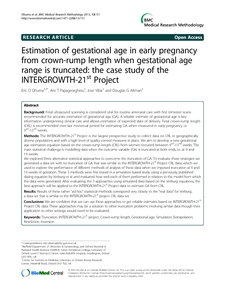Ohuma, EO; Papageorghiou, AT; Villar, J; Altman, DG
(2013)
Estimation of gestational age in early pregnancy from crown-rump length when gestational age range is truncated: the case study of the INTERGROWTH-21st Project.
BMC Medical Research Methodology, 13 (151).
ISSN 1471-2288
https://doi.org/10.1186/1471-2288-13-151
SGUL Authors: Papageorghiou, Aris
![[img]](https://openaccess.sgul.ac.uk/107237/1.hassmallThumbnailVersion/Estimation_of_gestational_age.pdf)  Preview |
|
["document_typename_application/pdf; charset=binary" not defined]
Published Version
Download (3MB)
| Preview
|
Abstract
BACKGROUND: Fetal ultrasound scanning is considered vital for routine antenatal care with first trimester scans recommended for accurate estimation of gestational age (GA). A reliable estimate of gestational age is key information underpinning clinical care and allows estimation of expected date of delivery. Fetal crown-rump length (CRL) is recommended over last menstrual period for estimating GA when measured in early pregnancy i.e. 9+0-13+6 weeks.
METHODS: The INTERGROWTH-21st Project is the largest prospective study to collect data on CRL in geographically diverse populations and with a high level of quality control measures in place. We aim to develop a new gestational age estimation equation based on the crown-rump length (CRL) from women recruited between 9+0-13+6 weeks. The main statistical challenge is modelling data when the outcome variable (GA) is truncated at both ends, i.e. at 9 and 14 weeks.We explored three alternative statistical approaches to overcome the truncation of GA. To evaluate these strategies we generated a data set with no truncation of GA that was similar to the INTERGROWTH-21st Project CRL data, which we used to explore the performance of different methods of analysis of these data when we imposed truncation at 9 and 14 weeks of gestation. These 3 methods were first tested in a simulation based study using a previously published dating equation by Verburg et al. and evaluated how well each of them performed in relation to the model from which the data were generated. After evaluating the 3 approaches using simulated data based on the Verburg equations, the best approach will be applied to the INTERGROWTH-21st Project data to estimate GA from CRL.
RESULTS: Results of these rather "ad hoc" statistical methods correspond very closely to the "real data" for Verburg, a data set that is similar to the INTERGROWTH-21st project CRL data set.
CONCLUSIONS: We are confident that we can use these approaches to get reliable estimates based on INTERGROWTH-21st Project CRL data. These approaches may be a solution to other truncation problems involving similar data though their application to other settings would need to be evaluated.
| Item Type: |
Article
|
| Additional Information: |
© 2013 Ohuma et al.; licensee BioMed Central Ltd. This is an open access article distributed under the terms of the Creative Commons Attribution License (http://creativecommons.org/licenses/by/2.0), which permits unrestricted use, distribution, and reproduction in any medium, provided the original work is properly cited. |
| Keywords: |
Computer Simulation, Crown-Rump Length, Female, Fetal Development, Gestational Age, Humans, Pregnancy, Reference Values, Ultrasonography, Prenatal, General & Internal Medicine, 1117 Public Health And Health Services |
| SGUL Research Institute / Research Centre: |
Academic Structure > Institute of Medical & Biomedical Education (IMBE) > Centre for Clinical Education (INMECE ) |
| Journal or Publication Title: |
BMC Medical Research Methodology |
| ISSN: |
1471-2288 |
| Language: |
eng |
| Dates: |
| Date | Event |
|---|
| 7 December 2013 | Published |
|
| PubMed ID: |
24314232 |
 |
Go to PubMed abstract |
| URI: |
https://openaccess.sgul.ac.uk/id/eprint/107237 |
| Publisher's version: |
https://doi.org/10.1186/1471-2288-13-151 |
Statistics
Item downloaded times since 20 Jan 2015.
Actions (login required)
 |
Edit Item |



